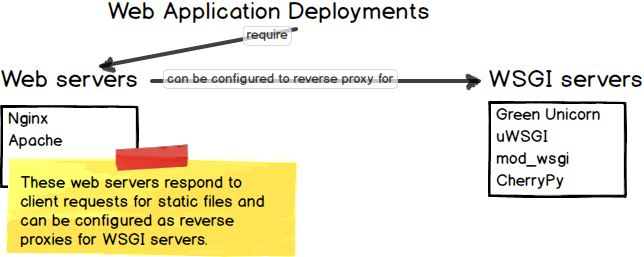Nginx
Nginx is the second most common web server among the top 100,000 websites. Nginx also functions well as a reverse proxy to handle requests and pass back responses for Python WSGI servers or even other web servers such as Apache.

Should I use Nginx or the Apache HTTP Server?
Let's be clear about these two "competing" servers: they are both fantastic open source projects and either will serve your web application deployment well. In fact, many of the top global web applications use both servers in their deployments to function in many steps throughout the HTTP request-response cycle.
I personally use Nginx more frequently than Apache because Nginx's configuration feel easier to write, with less boilerplate than alternatives.
There's also a bit of laziness in the usage: Nginx works well, it never causes me problems. So I stick with my battle-tested Ansible configuration management files that set up Nginx with HTTPS and SSL/TLS certificates
Securing Nginx
Nginx's default configuration after a standard installation through a system package manager or compiling from source is a good base for security. However, setting up ciphers and redirects can be confusing the first few times you try it. It's a really good idea to read some of these tutorials to make sure you are avoiding the most common security errors that plague HTTP(S) configurations.
-
Hacker News broke our site – how Nginx and PageSpeed fixed the problem is primarily about optimizing Nginx's configuration for more efficient SSL connections. The post also covers configuration management with Ansible as well as the Pagespeed module that Google released for both Nginx and the Apache HTTP Server.
-
Secure Web Deployment with Let's Encrypt and Nginx is a detailed walkthrough for setting up HTTPS under Ubuntu 14.04 with Nginx.
-
How To Secure Nginx on Ubuntu 14.04 explains SSL configurations and IP address blacklisting then provides several other tutorials for more advanced security modules.
-
Strong SSL Security on Nginx shows how to mitigate high profile SSL attacks like Logjam, Heartbleed and FREAK.
General Nginx resources
-
The Nginx chapter in the Architecture of Open Source Applications book has a great chapter devoted to why Nginx is built to scale a certain way and lessons learned along the development journey.
-
Inside Nginx: How we designed for performance and scale is a blog post from the developers behind Nginx on why they believe their architecture model is more performant and scalable than other approaches used to build web servers.
-
Test-driving web server configuration is a good story for how to iteratively apply configuration changes, such as routing traffic to Piwik for web analytics, reverse proxying to backend application servers and terminately TLS connections appropriately. It is impressive to read a well-written softare development article like this from a government agency, although UK's Government Digital Service as well as USA's 18F and US Digital Service foster a far more credible culture than most typical agencies.
-
Nginx for Developers: An Introduction provides the first steps to getting an initial Nginx configuration up and running.
-
A faster Web server: ripping out Apache for Nginx explains how Nginx can be used instead of Apache in some cases for better performance.
-
Nginx vs Apache: Our view is a first-party perspective written by the developers behind Nginx as to the differences between the web servers.
-
Rate Limiting with Nginx covers how to mitigate against brute force password guessing attempts using Nginx rate limits.
-
Nginx with dynamic upstreams is an important note for setting up your upstream WSGI server(s) if you're using Nginx as a reverse proxy with hostnames that change.
-
Nginx Caching shows how to set up Nginx for caching HTTP requests, which is often done by Varnish but can also be handled by Nginx with the
proxy_cacheand related directives. -
Nginx web server tutorials are oldies but goodies on setting up previous versions of Nginx.
-
Dynamic log formats in nginx explains how to use the HttpSetMiscModule module to transform variables in Nginx and map input to controlled output in the logs. The author uses this technique for pixel tracking but there are other purposes this method could be used for such as advanced debugging.
Continue learning about web servers or move to a new topic?

Searching for a complete, step-by-step deployment walkthrough? Learn more about The Full Stack Python Guide to Deployments book.
Email Updates
Nginx
Need more detailed tutorials than you see here? Learn more about The Full Stack Python Guide to Deployments book.

